Tarrytown and the Lexington Avenue Bombing
During this same period, Berger, Berg, and Hanson also became active in anarchist labor rights groups and the Anti-Military League. Most of these organizations used the Ferrer Center at their hub for activities. Here individuals like Alexander Berkman, Emma Goldman, [1] Luigi Galleani, and members of the Anarchist Red Cross and the Industrial Workers of the World spent a great deal of their time. During these meetings, plans were made to stage protests at the Tarrytown, New York estate of Standard Oil magnate John D. Rockefeller, owner of the Ludlow mines in Colorado.
The Ludlow Massacre in Colorado and police dispersal of the Tarrytown protests enraged most radicals. In June, members of the Lettish Anarchist Red Cross, including Berg, Hanson, Berger, and IWW member Arthur Caron began plotting a bomb attack to assassinate Rockefeller.
Berg, Hanson, and Caron began to collect dynamite from various sources, storing it in Louise Berger's apartment on New York's Lexington Avenue. Meetings were held at the Ferrer Center, where the conspirators devised a plan in which Berg, Hanson, and Caron would to plant a bomb at Rockefeller's home in Tarrytown. The plot was scheduled for July 3, but for reasons unknown, the plan was called off at the last moment. The three men returned to Berger's apartment from Tarrytown with bomb in hand.
At 9 a.m. on July 4, 1914, Louise Berger left her apartment and walked to the office of the Anarchist newspaper known as the Mother Earth Bulletin, where she worked as an editor alongside Alexander Berkman. It has been assumed by some who knew her that Berger was going there to inform Berkman that the bomb had been readjusted and was ready. At 9:15 an explosion occurred from Berger's apartment at 1626 Lexington Avenue. Passers-by witnessed a shower of debris and rubble fall into the street. Jack Isaacson, a newspaper editor who lived around the corner from Berger, recalled a man's arm falling from the Lexington Avenue building into the street in front of him. [2] The three upper floors of the building were wrecked, while debris showered rooftops and the streets below. Large pieces of furniture were thrown hundreds of feet in the air by the blast.
The bomb had exploded prematurely, killing Carl Hanson, Charles Berg and Arthur Caron. A fourth person, Marie Chavez, was also killed. The blast threw Caron's body onto the mangled and twisted fire escape. The mutilated bodies of Marie Chavez and Hanson were found inside of the apartment. The blast had torn the body of Charles Berg into pieces, which were seen by spectators being thrown through the air onto the streets. In total, twenty other people were injured, seven of them severely enough to be hospitalized. Another man, an IWW member named Mike Murphy, was spending the night in the apartment, when the explosion occurred. Berkman and Berger attended the men's funerals. Berkman would later state that the Lexington Avenue explosion was the most meaningful anarchist event since the Haymarket riot. [3] On July 20, 1914 Berger and two other women visited jailed hunger striker Rebecca Edelsohn, who was protesting her confinement for failure to pay a $300 fine for speaking disrespectfully of the American flag.
The Manifesto and life in Soviet Russia
Louise Berger remained active in the United States anarchist movement for three more years. In 1917, after the October Revolution in Russia, she decided to leave the United States to return to her homeland and assist in the worker's revolution. Alexander Berkman and Emma Goldman had recently finished compiling a communique to their comrades in Russia titled Manifesto to the Russian Workers, Peasants, and Soldiers! to explain the state of the U.S. antiwar movement, in particular the recent imprisonment of Thomas Mooney and Warren Billings, convicted of the Preparedness Day bombings of 1916. Goldman and Berkman entrusted Louise Berger, (according to Goldman, one of "our closest and most dependable friends") [4] with a copy of the manifesto to take with her on her journey to Russia. Berger sailed from New York in August 1917 bound for Russia, along with journalist John Reed and several other prominent radicals. [5] On the voyage out she met another returnee, Senya Fleshin, and became his lover. [6]
Back in Russia, Berger and Fleshin rejoined other anarchists participating in the revolution. She eventually parted with Fleshin and traveled to Odessa, where she reportedly carried out "bank expropriations" as an armed robber (naletchiki) during the chaos of the Revolution. [5] [7] According to one source, she fell ill and died during the typhus epidemic that swept Russia in 1920 and 1921. [8] Another source claims that she was liquidated along with other anarchists by Bolshevik Cheka or Red Army security forces during the Trotskyist campaign [9] [10] against 'anarcho-bandits' and other dissident movements. [11]
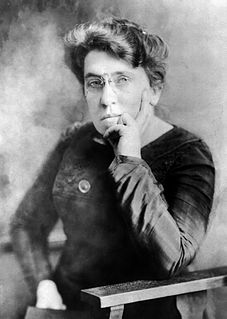
Emma Goldman was an anarchist political activist and writer. She played a pivotal role in the development of anarchist political philosophy in North America and Europe in the first half of the 20th century.

Alexander Berkman was a Russian-American anarchist and author. He was a leading member of the anarchist movement in the early 20th century, famous for both his political activism and his writing.
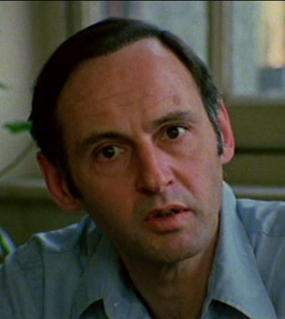
Paul Avrich was a historian of the 19th and early 20th century anarchist movement in Russia and the United States. He taught at Queens College, City University of New York, for his entire career, from 1961 to his retirement as distinguished professor of history in 1999. He wrote ten books, mostly about anarchism, including topics such as the 1886 Haymarket Riot, 1921 Sacco and Vanzetti case, 1921 Kronstadt naval base rebellion, and an oral history of the movement.

Luigi Galleani was an Italian anarchist active in the United States from 1901 to 1919. He is best known for his enthusiastic advocacy of "propaganda of the deed", i.e. the use of violence to eliminate those he viewed as tyrants and oppressors and to act as a catalyst to the overthrow of existing government institutions. From 1914 to 1932, Galleani's followers in the United States, carried out a series of bombings and assassination attempts against institutions and persons they viewed as class enemies. After Galleani was deported from the United States to Italy in June 1919, his colleagues are alleged to have carried out the Wall Street bombing of 1920, which resulted in the deaths of 40 people.
Anarchism in the United States began in the mid-19th century and started to grow in influence as it entered the American labor movements, growing an anarcho-communist current as well as gaining notoriety for violent propaganda of the deed and campaigning for diverse social reforms in the early 20th century. By around the start of the 20th century, the heyday of individualist anarchism had passed and anarcho-communism and other social anarchist currents emerged as the dominant anarchist tendency.
Senya Fleshin was an anarchist revolutionary and photographer.
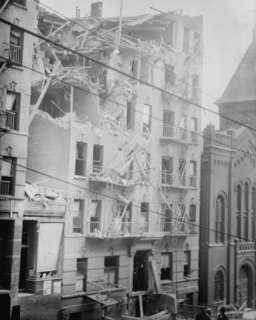
The Lexington Avenue explosion was the July 4, 1914, explosion of a terrorist bomb in an apartment at 1626 Lexington Avenue in New York City, New York, United States. Members of the Lettish section of the Anarchist Black Cross (ABC) were constructing a bomb in a seven-story tenement when the group's large supply of dynamite exploded prematurely. The blast destroyed most of the top three floors of the building, killing three conspirators and another renter who was not part of the bomb plot, as well as injuring dozens more.

This version of Mother Earth was an anarchist periodical aimed at the discussion of progressive issues. It was in circulation among people in the radical community in the United States from 1933–1934.

The 1919 United States anarchist bombings were a series of bombings and attempted bombings carried out by followers of the Italian anarchist Luigi Galleani from April through June 1919.

Now and After: The ABC of Communist Anarchism is an introduction to the principles of anarchism and anarchist communism written by Alexander Berkman. First published in 1929 by Vanguard Press, Now and After has been reprinted many times, often in partial or abbreviated versions, under the titles What Is Communist Anarchism?, What Is Anarchism? or The ABC of Anarchism.
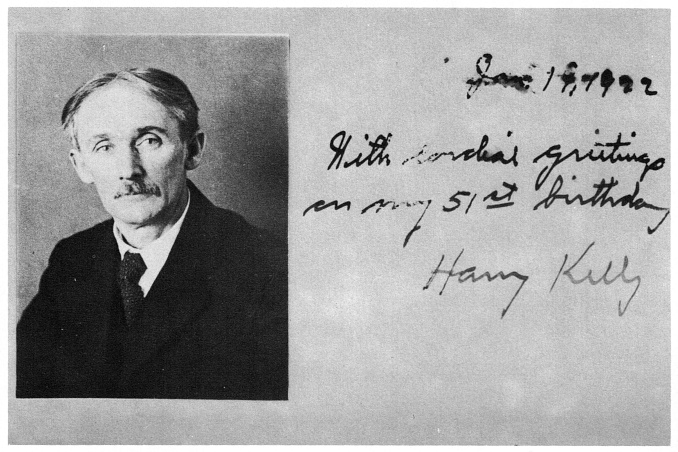
Harry May Kelly (1871–1953) was an American anarchist and lifelong activist in the Modern School movement.

Saul Yanovsky (1864–1939) was an American anarchist and activist. He is best remembered as the editor of the periodicals Freie Arbeiter Stimme (1890–1977), Arbeter Fraynd (1885-1914), Di Abend Tsaytung (1906) and the monthly literary publication Die Fraye Gezelshaft (1910–11). He was a member of the jewish-anarchist group Pioneers of Liberty.
Alexander "Sanya" Moiseyevich Schapiro or Shapiro was a Russian anarcho-syndicalist activist. Born in southern Russia, Schapiro left Russia at an early age and spent most of his early activist years in London.
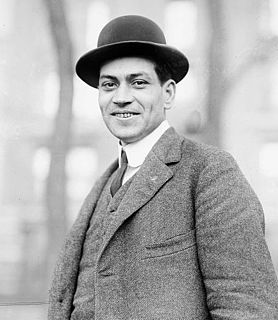
Arthur Caron was a French Canadian anarchist and a member of the Industrial Workers of the World. He masterminded an attempt to assassinate John D. Rockefeller using a bomb constructed from dynamite. While building the device, he was killed along with Carl Hanson, and Charles Berg on July 4, 1914, when his bomb prematurely exploded. The blast also killed a renter of the building who was not part of the plot and injured dozens of others. In the wake of Caron's death, some 5,000 mourners gathered in New York's Union Square, where anarchist leaders Alexander Berkman and Rebecca Edelsohn among others spoke in memory of those who died.
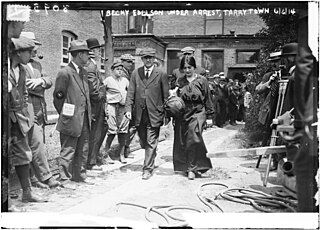
Rebecca Edelsohn, in contemporary sources often given as Becky Edelson, (1892–1973) was an anarchist and hunger striker who was jailed in 1914 for disorderly conduct during an Industrial Workers of the World speech. According to The New York Times, she was the first woman to attempt a hunger strike in the United States.
Boris Yelensky was a Russian anarchist propagandist from the early 20th century. Born in Russia in 1889, he participated in the 1905 Revolution, later migrating to the US, returning to take part in the 1917 Revolution and migrating once more to the US. Once there, he became a prominent figure in the anarchism movement, particularly in the Anarchist Red Cross in Chicago.

Modest Stein (1871–1958), born Modest Aronstam, was a Russian-born American illustrator and close associate of the anarchists Alexander Berkman and Emma Goldman. He was Berkman's cousin and intended replacement in the attempted assassination of Henry Clay Frick, an industrialist and union buster, in 1892. Later Stein abandoned active anarchism and became a successful newspaper, pulp magazine, and book illustrator, while continuing to support Berkman and Goldman financially.

Sasha and Emma: The Anarchist Odyssey of Alexander Berkman and Emma Goldman is a 2012 history book about Alexander Berkman and Emma Goldman. The book was co-authored by the father-daughter pair Paul and Karen Avrich, and posthumously published after Paul's death. It was a New York Times Book Review Editors' Choice for 2012.
Hillel Solotaroff (1865–1921) was a doctor known for his leadership in the New York Jewish/Yiddish anarchist movement. Solotaroff emigrated from Elizabetgrad in 1882 and while he pursued medical school, wrote for anarchist publications and was an exceptionally popular speaker. He became a member of the Jewish anarchist group Pioneers of Liberty and introduced the anarchist duo Emma Goldman and Alexander Berkman. Solotaroff continued writing through his life for various publications, writing a daily column for yiddish-language daily newspaper Der Tog. Later in his life, Solotaroff's views moved towards nationalism and Socialist Zionism.














